7 Top Rated Motorcycle Tire Pressure Monitoring Systems
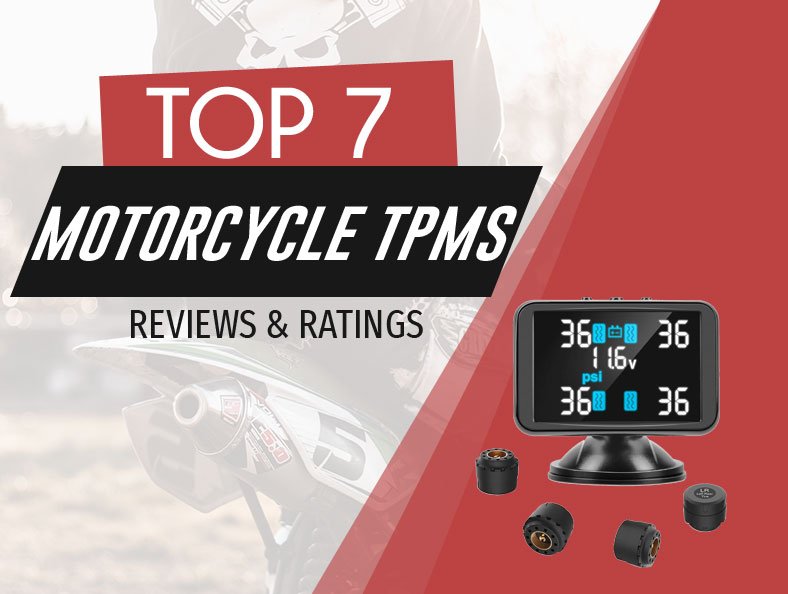
Road Racerz is proudly supported by our readers. Products purchased through links on our site may provide us a commission. Learn More
One of the most annoying things in motorcycling is ending up with a flat tire. Not only is this inconvenient, but it’s often dangerous, especially when riding at high speeds.
For this reason, you should consider using a motorcycle tire pressure monitoring system (referred to as TMPS). The top motorcycle TPMS is a handy device that helps to track tire pressure, making your rides safer.
However, you can find many different options on the market. Choosing one takes time, which is why we’ve reviewed the best models in the article below. You’ll also find our buyer’s guide with some valuable information on finding what suits you the most.
7 Highest Rated Motorcycle TPMS Reviews
| PRODUCT | FEATURES | |
|---|---|---|
Tymate  | Tymate Features: Four external sensors, lightweight and small Battery Type: 4 Lithium Metal batteries included | Check Price |
INFITARY 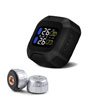 | INFITARY Features: Completely wireless, auto-alarm function Battery Type: Built-in lithium battery | Check Price |
SYKIK 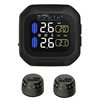 | SYKIK Features: Waterproof sensors Battery Type: Built-in rechargeable battery | Check Price |
FOBO 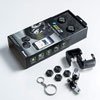 | FOBO Features: Real-time monitoring, multiple modes Battery Type: 2 Lithium Metal batteries included | Check Price |
STEELMATE 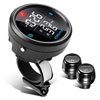 | STEELMATE Features: Two ways to install, real-time monitoring Battery Type: Batteries not included | Check Price |
NEWekey 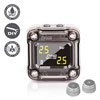 | NEWekey Features: No-wires connection, Battery Type: 2 C batteries included | Check Price |
KKmoon Store 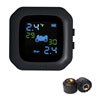 | KKmoon Store Features: Mounting bracket included, real-time monitoring Battery Type: 3 Lithium ion batteries included | Check Price |
Tymate – Flexible Charging
Tymate features a large and colorful screen that has big icons and font displays. It’s easy to read, allowing you to monitor the condition of the tires.
This one has four alarm modes, including low pressure, high pressure, rapid air leakage, and high temperature. It reports any abnormal tire condition since you can set minimum and maximum alarm values.
It’s pretty flexible, which means you can charge it in several ways. Use a USB interface or a car cigarette lighter, depending on your possibilities. Also, this one has a sensor that tells you when you should charge the car battery.
It has four external sensors that use little power, so you get about two years of working life. It’s small and compact, providing high accuracy and weather resistance.
PROS
- Four external sensors
- Lightweight and small
- High accuracy
CONS
- Low-quality adapter
INFITARY – Wireless
Infitary is a wireless device that measures tire pressure and temperature, displaying the information simultaneously. It updates every three seconds, using visual and sound warning if something is wrong.
It has an auto-alarm that sets off when temperature and pressure are abnormal. Keep in mind that you can set it up to use either PSI or BAR. It also has two temperature units, allowing you to choose between °C and °F.
It’s a highly accurate system, displaying information for both tires at the same time. On top of that, it’s suitable for motorcycles and every other two-wheeled vehicle.
This one has a built-in lithium battery with a mini USB charging port. It has a LED panel and two external sensors to improve fuel efficiency. Another thing worth noting is that it’s IP5K4K waterproof and dustproof.
PROS
- Completely wireless
- Easy to install
- Auto-alarm function
CONS
- Tricky to see in daylight
SYKIK – Water Resistant
This one might be your best choice if you’re looking for a water-resistant device. It measures the pressure in your tires, preventing flat tires and making your rides safer.
The 1.5’’ monitor is water-resistant, which means it can withstand some rain and moisture. This is ideal for commuters and everyday riders who ride in variable weather.
Also, the device has a built-in battery that’s rechargeable that should last up to 12 months. It’s quite reliable and highly accurate, making it easy to rely on the data it shows.
Another thing worth mentioning is that you can change it to Fahrenheit and PSI. This makes it versatile and suitable for more people with different needs and preferences.
The sensors included are fully waterproof and provide reliable info on pressure and temperature.
PROS
- Multi-color display
- Rechargeable battery
- Waterproof sensors
CONS
- Hard to read in the sunlight
FOBO – Bluetooth
Fobo is a smart tire pressure monitoring system that works on all motorcycles and two-wheel vehicles. It uses Bluetooth 5.0 technology that connects to your smartphone.
It works the best with iOS 9.3 and Android 5.0, so make sure that you have a compatible device to pair it with. It shows the information on pressure and temperature in real-time, making it easy to track this data at all times.
On top of that, this one alerts you of anomalies by detecting slow or fast leaks. It sends instant audio, text, and haptic alerts on your smartwatch, smartphone, or whatever other devices you connect it with.
Fobo is easy to install on every motorcycle. Best of all, you don’t have to drill any holes or run wires through your vehicle.
PROS
- Real-time monitoring
- Multiple modes
- Bluetooth compatible
CONS
- The data is only shown on your phone
STEELMATE – Universal
This universal TPMS system contains a precision wireless transmission sensor. It allows real-time temperature and pressure monitoring for both tires at the same time.
It doesn’t only measure this data but uses a real-time alarm to notify you of the issue. It’s easy to read as it has a large LCD.
The system helps to save fuel and extend tire service life. It predicts air leakage and balances tire pressure to improve your driving safety.
It’s easy to install thanks to the bracket, and adhesive holder included. It fits most handlebars, including Honda, BMW, Harley Davidson, Yamaha, Indian, KTM, Victory, and Suzuki.
The package includes two external sensors, a display, an adhesive holder and clamp, three spare washers, and an extra nut, along with a sensor tool and a spanner.
PROS
- Installation hardware included
- Real-time monitoring
- Two ways to install
CONS
- Not the brightest screen
NEWekey – Durable
NEWekey is one of the most durable options, so it might be worth your attention if you like off-road riding. It features a precision wireless transmission sensor, providing accurate reading and real-time information.
The monitor sends an audiovisual alarm to notify you of whatever abnormality in your tires’ pressure and temperature. The design is IP67 waterproof and dustproof, allowing you to enjoy rough off-road adventures.
It comes with a built-in lithium battery and a USB port for charging. You get an LCD panel and two external high-sensitivity sensors.
The best thing is that the screen goes to sleep mode when you stop the bike, helping to extend the battery’s life. On top of that, the device improves fuel efficiency and adds a bit more to your safety while riding.
PROS
- No-wires connection
- Highly accurate sensors
- Waterproof and dustproof
CONS
- It only measures in °C
KKmoon Store – LCD Display
This might be your best choice if you’re looking for a motorcycle TPMS with an LCD and real-time monitoring. It’s waterproof and dustproof, so it’s perfect for off-road adventures and everyday riders.
This shows data for both tires simultaneously, allowing you to track pressure, temperature, and other essential aspects. Its sensors are highly accurate, so the device helps to improve fuel efficiency and prevent air leakage.
It comes with a mounting bracket, allowing simple installation that shouldn’t take more than a few minutes. You’ll also receive instructions on installing and using it, although many people complain due to lack of details.
The package includes a monitor, a USB cable, a holder, a spanner, two nuts, two external sensors, and two cell keys. It’s cordless and weighs only 7.76 ounces.
PROS
- Mounting bracket included
- Real-time monitoring
- Tracks pressure and temperature
CONS
- Poorly written instructions

Tire Pressure Monitoring System for Motorcycles Buying Guide
Compatibility
The first thing you should remember is that not all systems are compatible with all motorcycles. For this reason, you should check a few factors before making your final decision.
Although most internal sensors fit just fine, external sensors might not fit so easily. Also, remember that some devices can’t work with rubber valves.
It’s essential to research your options well before buying any particular system. As you noticed, the market offers plenty of models, so make sure to find what fits your bike the best.
Battery Type
Most TPMS systems come with rechargeable batteries, although some devices have replaceable batteries instead.
Think about which of the two options you find more convenient. Recharging batteries is often more eco-friendly than having to replace them. However, replaceable ones are easier to change if your device dies while on the road.
Ensure that battery replacements for sensors are also available. If not, you’ll probably have to buy another device once these stop working. Another thing worth noting is the lifespan.
Mounting
External TPMS systems are easy to install since nearly every model comes with holders, mounts, or brackets. These are designed for round handlebars and are pretty simple to attach.
Still, some companies offer alternative mounting options. As you’ve noticed, some models come with adhesive holders that can help mount the external system.
The first thing you should do is figure out where you want to mount the monitor. Also, check if the device of your choice comes with a mounting method you prefer.
Waterproofing
Waterproofing is possibly one of the most critical things to look for. It’s especially important if you usually ride in variable weather and rain showers.
Look for both waterproof and weatherproof ones because these are the best when it comes to withstanding different conditions. They’ll continue to track the pressure and temperature of your tires even when it rains.
Make sure to give this a good thought because a device that can’t stand a little rain will probably be useless to you.
Counterfeits
You’ll probably come across counterfeit TPMS on various websites. While not all of them are that bad, most are somewhat unreliable if you ride at high speeds.
Counterfeit systems fail easily and present a specific risk you shouldn’t take when riding 80 miles an hour. You can end up with a flat tire and have your system show no abnormalities at all.
Use your judgment when buying a TPMS system to avoid ending up with a device that’s less than quality-made.
What is TPMS?
TPMS stands for a tire pressure monitoring system. It’s an electronic kit with a display and sensors working together to inform you of tire pressure and temperature.
It’s a reliable device that informs you when the tire pressure drops below the optimal range. Some systems show information on your bike’s power voltage and several other factors.
The market offers plenty of different models, allowing you to choose the best versatility, compatibility, and accessibility. Some connect to your phone via an app, making it easier to use and control the device without any special instructions.

How it Works
These come as two different models, using various methods to measure both pressure and temperature. A direct TPMS has a sensor that you mount on one of the wheels.
The sensor will notify you if the pressure drops below 25% of the recommended. This way, you can avoid air leakage and other similar accidents that could occur on the road.
These typically come with instructions so that you can learn how your particular model works.
Why You Should Own One?
Convenience
Using a TPMS system is much easier than trying to check tire pressure manually. Manual checking often involves lying on the ground or struggling to find valve steam somewhere under your saddlebags.
These systems are much more convenient and always tracking the state of your tires. Plus, some of these come with advanced features that allow you to track more than just pressure and temperature.
Safety
Tracking if your tires are properly inflated helps to increase your overall safety. Your monitor will notify you if there’s a puncture, a slow leak, or any change in tire pressure.
This makes your riding experience much safer than if you would check the pressure manually from time to time.
Upgrade
You might have noticed that modern motorcycles have built-in TPMS systems. Older bikes don’t have this, but that doesn’t mean you can’t update your ride.
Aftermarket TPMS devices are easy to find, install, and use. You can still improve your safety, which is especially important if you love off-road riding.
Monitoring
A tire pressure monitoring system’s primary purpose is to notify you when your tires have too little or too much air pressure.
Many models read your tires’ temperature as well, providing useful information on how heated the wheels are as you ride.
Different Types of Sensors
Internal
Pros
Internal sensors hide inside the rim, so they’re discreet and invisible. They won’t ruin the look of your wheels since they’re difficult to notice.
These show pressure and temperature, which makes them ideal for variable weather. On top of that, they’re well-protected from weather elements as well.
Internal sensors are difficult to steal because they’re hidden inside the rim. Also, internal sensors allow you to inflate your tires easily since they leave valve stem free.
Cons
The first thing we should mention is that these are quite expensive. They’re not too expensive, but the pricier among all the other systems.
Installation is also quite tricky because you have to remove the entire wheel. It’s quite a lot of work, especially if you don’t have much experience. In this case, you might want a mechanic to help you.
They’re rather inconvenient to recharge and maintain because you’ll have to remove the wheel again for each of these actions.
External
Pros
External sensors are cheaper to buy than internal ones. This is an excellent option if you’re looking for a more affordable system to track your tires’ pressure and temperature.
On top of that, external ones are also easier to install since you don’t have to remove the entire wheel. The fact that you don’t have to remove the wheel means these are easier to maintain without anyone’s help.
You can charge and maintain them by yourself without having to pay a professional.
Cons
External sensors are out there in the open for everyone to see them. This makes them an easy target for thieves.
Although they’re relatively easy to steal, some of these devices come with special locking mechanisms that are somewhat trickier to break.
These are easily affected by weather elements, so the readings you get aren’t always accurate. Plus, make sure to check the dimensions before buying because external sensors aren’t the most compatible.
Digital
Digital ones have a monitor that you attach to your handlebars. The monitor shows the data and information on temperature, pressure, and other similar things.
It’s a popular option because it allows you to check your wheels’ state as you ride. You usually don’t have to pull over and check since the monitor is right in front of you.
However, not all of them are waterproof, and some are tricky to read in direct sunlight.
App
You might want to go for a Bluetooth connected system if you don’t like the idea of having a monitor fixed to your handlebars.
These devices use Bluetooth to connect to your phone, smartwatch, or headset. They read the information the same way but send it to your gadget instead of a monitor.
An app-enabled system is convenient and easy to use only if the connection is dependable and won’t break while you ride. Some digital models have both a monitor and Bluetooth connectivity.
Motorcycle TPMS Helpful Tips
The first thing we should mention is that you should avoid new cheaply-made systems. Stay away from unknown brands because they’re often unreliable.
Look for a device with advanced features because they can make the overall use much easier. Although they’re typically a little expensive, modern devices connect to your phone and send notifications on tire pressure and temperature.
Also, take some time to read the installation instructions. You must install it properly, or the system might not work.
Frequently Asked Questions
Are displays better than apps?
The two systems can work equally well, given that you choose a quality-made product. The only difference is in ease of use, so it’s up to you to choose among them.
Consider both options and their pros and cons so that you can figure out which of the two fits your needs better.
How can I install a TPMS?
All you have to do is attach the rear and front sensors on the correct tires. Use jam nuts and a wrench to prevent it from ending up in the wrong hands.
Use the mounting bracket provided to attach the monitor to the handlebar. Also, check the battery because some are rechargeable.
Are metal TPMS valve stems better than rubber types?
Metal valve stems are better and more reliable than rubber ones. Rubber corrodes and breaks easily, mostly if you ride every day and in variable weather.
Although metal lasts longer, you should still check what the manufacturer recommends as the best option. Don’t forget to consider your needs and preferences as well.
Conclusion
Getting a reliable TPMS system is one of the best things you can do if you’re looking to upgrade your motorcycle. Not only this makes it easier to maintain your motorbike, but it also helps to improve your safety.
You can avoid air leakage, notice small punctures, and avoid getting a flat tire using TPMS. It’s a handy device that’s simple to install and use regardless of the bike you ride.
However, choosing one isn’t as simple, so make sure to consider the information we shared in the buyer’s guide. It can help you pick one of the systems we reviewed since these are the best that the market offers right now.













